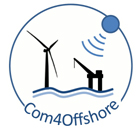
Objectives of the service
The "20-20-20 targets" approved by European Commission in March 2007 require major infrastructure developments to meet the demands in terms of renewable energies. Renewable energies are a key pillar of these initiatives, wind power being the most promising and mature technologies. Nevertheless, to achieve the established targets, a significant increase of the installed capacity as well as efficiency is necessary.
In the particular case of wind power, going offshore is seen as the trend: larger turbines can be placed over enormous areas with vast wind potential without disturbing the population. The European Wind Energy Association (EWEA) estimates that by 2020 40 GW of offshore wind capacity is expected to be added in European waters, increasing to 110 GW between 2020 and 2030. These figures imply the construction of more than 9,000 wind energy turbines in locations between 30 and 200 km away from the coast in water depths between 10 and 60 metres. Particularly countries like the UK and Germany plan to build wind power plants generating 13 respectively 6.5 GW by 2020.
Technical challenges are huge in terms of foundations, tower construction, turbines, cabling, network connectivity, operation and maintenance. As such, the conditions (open sea, harsh environment) require large efforts for construction planning, logistic processes, safety of the locally working personnel as well as the structures deployed.
In order to tackle this problem, the current developments in satellite based communication and navigation shall be used to establish a communication infrastructure for the offshore wind energy business. As the participants are often mobile and travel between the offshore sites and the harbours, the available services change with the location.
The Com4Offshore approach aims in providing the technically and economically optimal solution to the users with respect to their location. The system has to combine wireless and mobile network technology near shore and within the wind park area. However, in extended offshore areas between the wind farms and ports, satellite based services are the only choice.
Users and their needs
From a user point of view, having the possibility to report delays in the installation process or weather conditions directly to the control room ashore, would be a significant improvement on the supply chain (and reduce the logistic costs). They all need to be in close contact to understand the status of the on-going construction works and plans accordingly:
- Onshore partners include the management of the off-shore wind farm owners, logistics and construction companies, as well as insurance, financing parties, search and rescue authorities. All construction and commissioning management work, logistic operations, contract assignments and coordination amongst different companies are done on-shore.
- Offshore partners include construction and logistic companies (ships, material, personnel), as well as observers belonging to other groups (owners, financiers, insurers, etc.).
Service/ system concept
The Com4Offshore solution comprises the access to communication services and hardware devices with included software applications. The system is flexible in layout and can be adapted for single user needs.
Space Added Value
The currently used services are fragmented and not reliably available. The actual workflow is based on compromises and lacks a dedicated solution. Therefore, there is a strong demand to build a unified approach that can help companies to work as much as possible on the same basis as in onshore construction sites. In this respect, the integration of various space technologies is expected to significantly improve the construction process of offshore wind farms.
- Satellite communications. Before starting the construction of a wind farm there is no communication infrastructure available on the off-shore site. Satellite communications are an easy, robust and secure way of establishing high-data rate multipurpose communications between on-shore and offshore players and when needed. In addition, Satcom is considered as a cost effective backup service for fibre optic connections between the transformer platform and the fixed terrestrial network at shore during the operation phase of the wind park.
- Satellite Navigation. By incorporating GNSS solutions and having an appropriate communications infrastructure, it will be possible to track and trace staff, material, and equipment through the whole construction process, plan and manage the work more efficiently, and support search and rescue operations when necessary.
- Earth Observation. Weather data complemented by other sea state information from Earth Observation satellites and integrated with weather and sea state information from sensors installed on site will improve the situational awareness in the construction and logistics areas.
Current Status
The feasibility study was completed in April 2014. The follow-on demonstration project started in June 2015.



